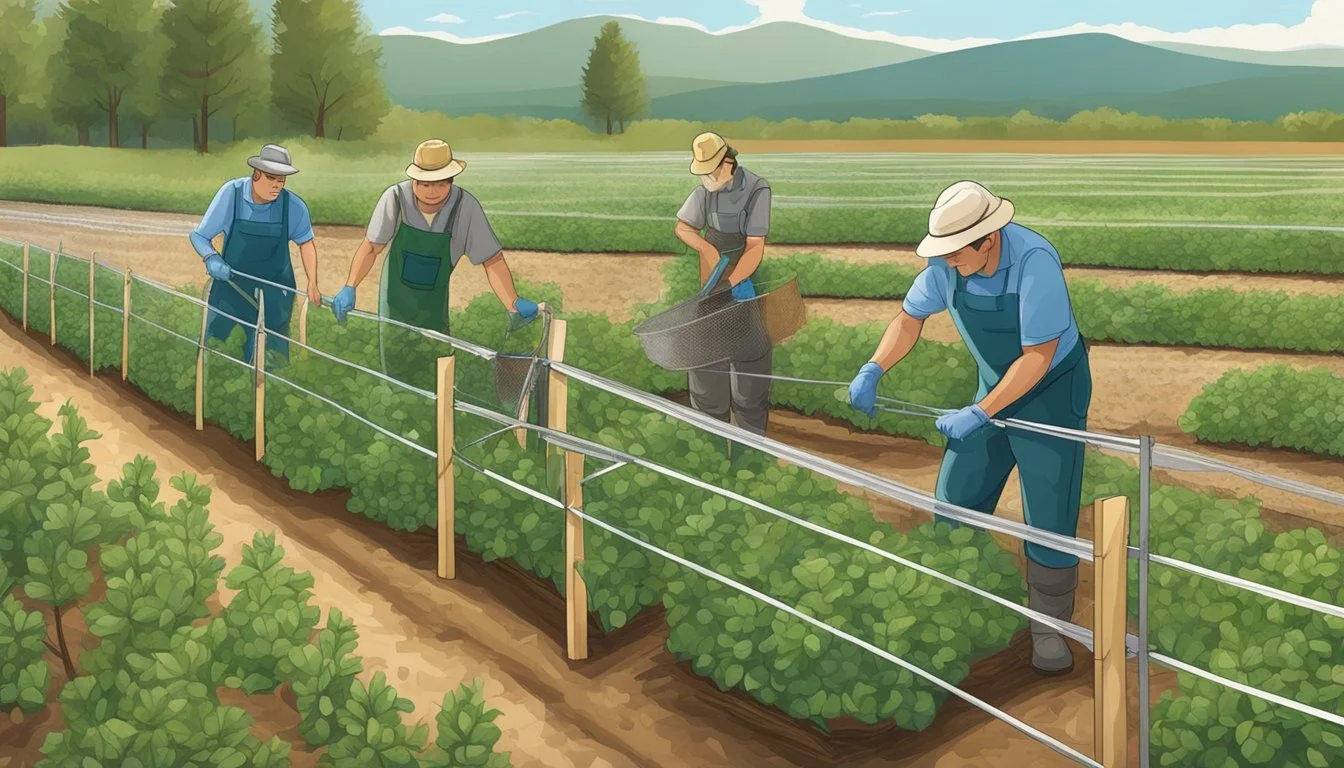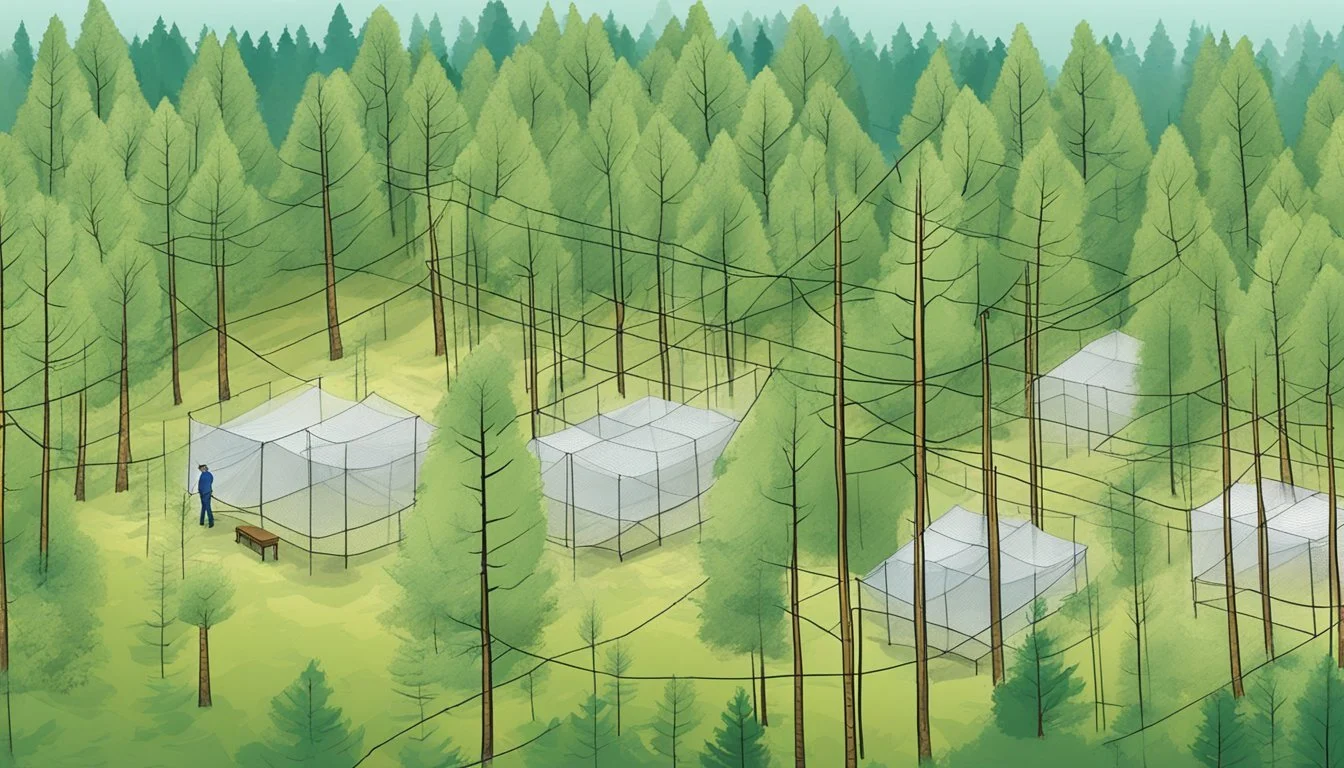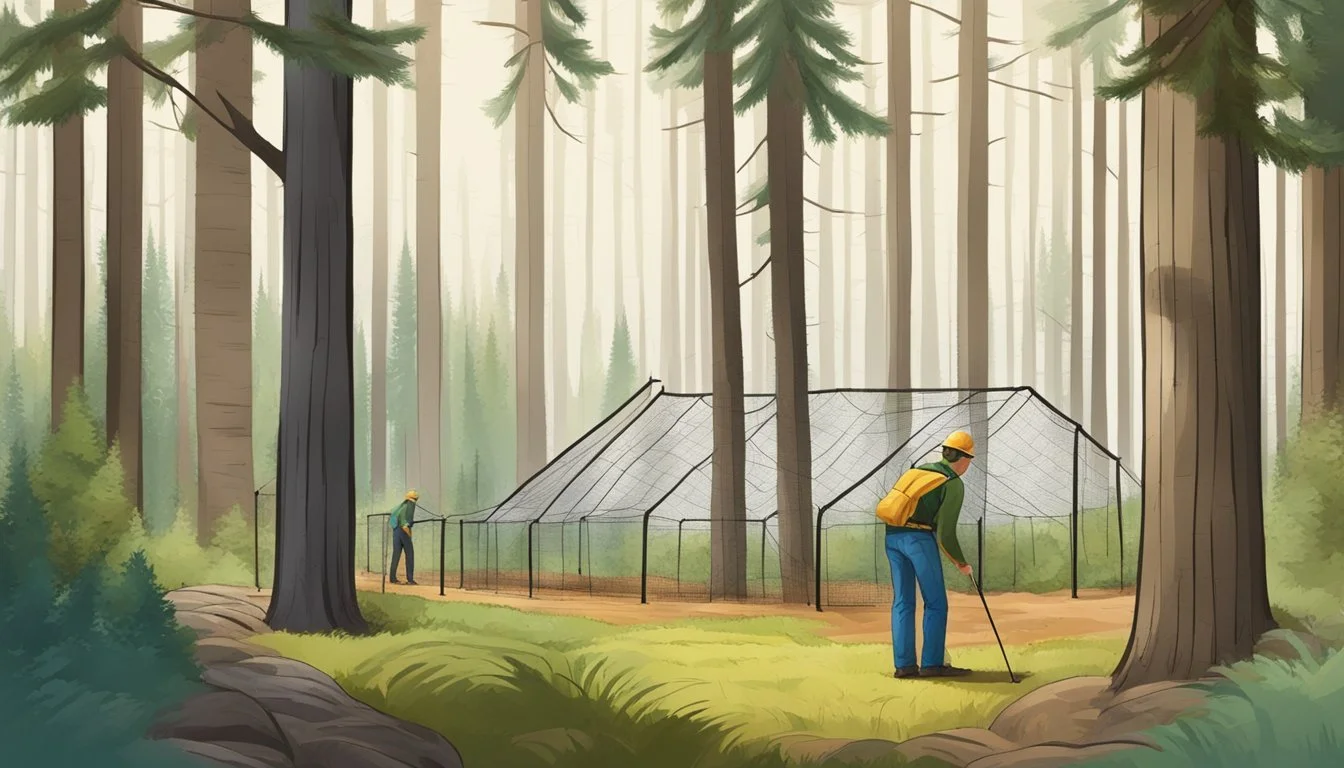Protecting Crops from Bark Beetles
Effective Strategies for Farmers
Protecting agricultural and forested lands from bark beetle infestations is a critical task for maintaining healthy ecosystems and safeguarding the livelihood of many who depend on these resources. Bark beetles, which belong to the family Scolytidae, bore into trees to lay their eggs, disrupting the flow of nutrients and often resulting in tree mortality. Their ability to kill a vast number of trees has made them one of the most destructive forest pests on the continent. Given the right conditions, such as drought-stressed trees or overstocked stands, they can cause extensive damage that disrupts ecosystems and forest industries.
Effective forest management practices are essential in the fight against these insects. By promoting the growth of mixed-age and mixed-species stands, forest managers can create less favorable conditions for the spread of beetles. Such practices not only help to preserve the health and diversity of forests but also contribute to the resilience of trees against bark beetle attacks. Additionally, proactive measures like thinning dense stands of trees and removing infested or vulnerable trees can reduce the likelihood of large-scale outbreaks.
As the scenario of bark beetle infestations grows more complicated with changing climatic conditions, it becomes increasingly important to employ a variety of management techniques. Insecticides can provide an effective preventative treatment, while non-chemical methods, including maintaining tree vigor through proper irrigation and thinning, are equally significant. Novel approaches like the use of semiochemicals, such as verbenone, mimic the beetles' chemical communication, dissuading further colonization. Understanding bark beetles and adopting diverse management strategies are integral steps to protect forests and crops, preserving biodiversity and sustaining industries that depend on these critical natural resources.
Understanding Bark Beetles
Bark beetles are significant pests that affect forest ecosystems, particularly in conifer forests. They belong to the order Coleoptera and are known for their wood-boring behavior that can damage and kill trees. This section will explore the biological aspects, various species and their distribution, as well as the ecological impact these insects have on their environments.
Biology of Bark Beetles
Bark beetles, specifically within the family Curculionidae, are small insects with hard exoskeletons. The subfamily Scolytinae includes numerous species of bark beetles, exhibiting a variety of life cycles and behaviors. Adult beetles bore through tree bark to lay their eggs. Once hatched, the larvae feed on the tree's vascular tissues, disrupting the flow of nutrients and water, potentially leading to the tree's death.
Species and Distribution
There are over 6,000 species of bark beetles globally, with the genus Dendroctonus being one of the most well-known due to their destructive nature. These beetles can be found in forests across the world, with each species having its specific range. For instance, the Dendroctonus ponderosae primarily infests ponderosa and lodgepole pines across North America.
Ecological Impact
Bark beetles play a complex role in their ecological system. While they are natural components of forest ecosystems, their behavior can lead to widespread tree mortality, altering the ecology and structure of forests. This has both positive and negative effects: it can provide opportunities for new growth and biodiversity, but also may result in significant losses in timber value, increased fire risk, and habitat loss for species dependent on the affected trees.
Bark Beetle Management Strategies
Effective bark beetle management is crucial for maintaining forest health and protecting ecosystem services. Adopting a comprehensive approach can prevent significant losses and ensure the preservation of timber supplies.
Integrated Pest Management
Integrated Pest Management (IPM) encompasses a variety of practices aimed at managing bark beetle populations in a sustainable manner. This approach involves regular monitoring, identification of beetle species, and assessment of infestation levels to inform decision-making. By understanding the ecology of the beetles and their relationship with the environment, managers can devise strategies that are environmentally sound and economically viable. Application of IPM strategies can be seen in Bark Beetle Management Guidebook procedures.
Preventive Measures
Preventative measures are key to mitigating the impact of bark beetles before they become a significant threat. Maintaining forest diversity, thinning dense stands, and removing weakened or infested trees can reduce beetle habitat and limit their spread. Enhancing tree vigor through appropriate silviculture treatments also makes the forest less susceptible to beetle attacks. Furthermore, pheromone baits can be used to disrupt beetle communication and mating, aiding in prevention efforts.
Direct Control Methods
When infestations occur, they may necessitate direct control methods to prevent further damage. These methods can include the application of insecticides to individual high-value trees or small-scale infestations, and removal or destruction of infested trees to eliminate beetle broods. Mechanical methods, such as debarking or chipping of infested wood, are non-chemical treatment options. In rapid outbreak scenarios, salvage logging may be employed to remove and utilize infested trees, thus reducing beetle populations. Research into these tactics can be found within resources like the Management tactics to reduce bark beetle impacts document.
Cultural and Chemical Control
Effective management of bark beetle infestations often requires an integrated approach, combining culturally grounded and chemically supported strategies to protect and maintain tree health. This intricate balance minimizes tree mortality and aids in sustaining forest ecosystems.
Silvicultural Practices
Silvicultural practices, such as thinning, play a critical role in maintaining forest health and mitigating bark beetle outbreaks. By removing weaker trees, thinning reduces competition for resources, thus improving the vigor of the remaining trees. It's imperative to consider that well-spaced trees are less susceptible to stress, which can otherwise lead to an increased risk of beetle attacks.
Insecticide Application
When it comes to chemical controls, insecticides such as cypermethrin are essential tools. Applicable as a contact insecticide, cypermethrin is used to coat the bark, targeting beetles as they land on trees. For greater systemic control, systemic insecticides can be introduced into a tree's vascular system, providing internal defense against beetle incursions. These insecticides can be more effective as they reach the beetles concealed within the bark.
In deploying insecticides, proper application is key. This includes:
Timing: Apply when beetles are active for maximum effect.
Dosage: Follow label rates to protect tree health and non-target organisms.
Coverage: Ensure thorough bark coverage to enhance insecticide efficacy.
Use of Pheromones: Integrate with pheromone-based tactics to disrupt beetle communication and attraction.
Mechanical and Biological Control
Effective management of bark beetles can involve a combination of mechanical methods like tree removal, and biological control through the introduction or support of natural predators and pathogens.
Tree Removal
Tree removal is a mechanical control strategy that involves cutting down and disposing of infested trees to reduce bark beetle populations. This method helps to interrupt the beetle's life cycle and prevent the spread to healthy trees. It is crucial for the removal to take place before new adults emerge and disperse. Trees that are already heavily infested or those posing a risk of infestation to others are prioritized for removal.
Natural Predators and Pathogens
Biological control leverages natural enemies such as predators, parasitoids, and pathogens to manage bark beetle populations. For instance, entomopathogenic fungi, which are natural pathogens, have been studied for their potential to control bark beetles with minimal environmental impact. Additionally, certain species of birds and insects act as predators or parasitoids, directly reducing beetle numbers by feeding on them or their larvae. However, the successful application of biological control agents in the field requires a thorough understanding of their interaction with target pests and the ecosystem.
Monitoring and Responding to Outbreaks
Effective management of bark beetle outbreaks relies on robust monitoring systems and strategic responses. Knowing when and how to act can mitigate the severe impacts of these infestations on forests and crops.
Early Detection and Identification
Early detection is pivotal to manage bark beetle outbreaks effectively. Utilizing remote sensing monitoring technology provides a large-scale view of forests, enabling the identification of affected areas. Additionally, field experts are essential for ground-level detection and confirmation of bark beetle presence.
Response Tactics
Once an infestation is confirmed, a variety of response tactics may be employed. Biological control agents, pheromone traps, and targeted pesticide use are common methods. Strategic thinning of forests can also reduce the likelihood of bark beetle spread, as noted in various management tactics to cope with the impacts of these beetles in North American forests.
Post-Outbreak Management
After a bark beetle outbreak has been addressed, post-outbreak management becomes critical. This includes continued surveillance to prevent re-infestation and restoration efforts to support forest recovery. Learning from each outbreak is important to improve future management strategies for bark beetles in conifer forests.
Research and Innovation in Bark Beetle Control
In the battle against bark beetles, significant strides have been made through innovations in semiochemical applications and genetic research. These developments are crucial in devising effective strategies to protect forested landscapes and agricultural interests.
Advances in Pheromone Technology
Researchers have largely focused on the utilization of semiochemicals, particularly pheromones, to manage bark beetle populations. Pheromone technology has evolved to the point where it can disrupt beetle mating behaviors and misdirect their search for hosts. One approach involves the deployment of pheromone traps which attract and capture beetles, thereby reducing the number of beetles available to infest trees. Moreover, the development of anti-aggregation pheromones can deter beetles from colonizing healthy trees, as highlighted in a ScienceDirect article, offering a non-toxic and environmentally friendly option for bark beetle management.
Genetic Resistance Research
On another front, genetic resistance research is uncovering potential long-term solutions to bark beetle outbreaks. Scientists are examining the genetic traits that enable certain trees to withstand beetle attacks. By identifying these resistant genes, there are opportunities to support breeding programs that enhance the resistance of trees at a genetic level. Significant efforts are made to understand the complex interactions between beetles and their host trees, leading to innovative approaches to forestry management and crop protection. This genetic angle represents a promising avenue for sustainable beetle control, aligning with the findings from a Springer research paper.
Understanding these pheromone and genetic-based strategies is fundamental for stakeholders seeking cutting-edge solutions to protect against bark beetle devastation.
The Role of Environmental Conditions
Environmental conditions play a crucial role in the management and prevention of bark beetle outbreaks. Climate and weather patterns, including temperature and moisture levels, are primary factors that influence bark beetle lifecycles and population dynamics. For instance, warmer temperatures can lead to multiple generations of beetles within a single year, potentially accelerating their spread. Conversely, cold snaps can decrease their numbers.
Site conditions, such as the availability of suitable host trees, also impact beetle populations. Bark beetles predominantly attack weakened or stressed trees; therefore, forests with a higher proportion of these trees are more susceptible to infestation. Preemptively managing forest health can moderate the risk and intensity of beetle outbreaks.
Moreover, fire plays a dual role in bark beetle ecology. Although fire can eliminate large quantities of bark beetles by destroying their habitat, it can also create conditions conducive to their spread by leaving behind weakened or burned trees. These trees become prime targets for surviving beetles, leading to potential flare-ups in beetle populations post-fire events.
Implementing strategies that integrate an understanding of the complex interplay between these environmental conditions can help protect crops and forests from the devastating impacts of bark beetles.
Protecting Specific Tree Species
Effective protection against bark beetles requires attention to the particular needs and vulnerabilities of different tree species. Proper management strategies can significantly decrease the likelihood of infestation and sustain forest health.
Conifer Protection
Lodgepole Pine & Engelmann Spruce: These conifers are often targeted by specific beetles, such as the pine bark beetle and the spruce bark beetle. To shield these trees, foresters must:
Maintain tree vigor through adequate spacing and thinning, which reduces stress and enhances resin defense systems.
Remove infected trees promptly to prevent the spread of beetles to healthy trees.
Monitoring and Control: Pheromone traps can detect beetle presence early, and insecticides may be judiciously applied when infestation levels warrant.
Hardwood Conservation
Elm & Oak: Unlike conifers, hardwoods like elm and oak are less frequently attacked by bark beetles, but they are not immune. To conserve these species:
Sanitation: Keep areas clean of dead or dying wood where beetles may breed.
Tree Health: Ensure soil health and appropriate watering to maintain robust hardwoods less susceptible to infestation.
For longleaf pine, practices similar to those for other conifers should be employed, with particular attention to reducing competition and avoiding tree injury which could attract beetles.
Impact on Human Activity
Bark beetles significantly affect human activities, particularly in the realms of timber production and the provision of ecosystem services. These small insects are known for their large-scale impacts on forests—effects that extend into economic and environmental sectors.
Effects on Timber Production
In the context of timber production, bark beetles can cause extensive damage to tree stands, resulting in economic losses. Forestry economies rely heavily on healthy trees, and when infestations occur, the value of timber can plummet due to the compromised structural integrity of the wood. For instance, areas such as Western North America have seen higher impacts of bark beetle species, leading to a significant decline in suitable lumber for the market. Infected trees often die, which means they cannot sequester carbon or produce oxygen, resulting in further implications for the atmosphere and climate regulation.
Influence on Ecosystem Services
Bark beetles also influence various ecosystem services that are vital to maintaining the balance of natural processes and systems that humans depend on. These services include:
Regulation of water cycles and water quality
Maintenance of soil fertility
Pollination of plants
Carbon storage
When bark beetles kill large areas of forest, these services can be disrupted. For example, changes in forest structure can lead to altered water runoff patterns and increased sedimentation in water bodies. Furthermore, dense beetle-killed forests may increase the risk of intense wildfires, which not only threaten human life and health but also release stored carbon dioxide back into the atmosphere. Although healthy bark beetle populations contribute to forest ecosystems by promoting decomposition and renewal, outbreaks can tip the balance and adversely affect service provisioning. Additionally, there is a concern for human health, as beetle infestations may have indirect effects, for example by influencing air quality due to changes in forest composition or through the aftermath of wildfires.
Summary and Future Outlook
The battle against bark beetles and their impact on forest structure and cover remains pivotal for the management of North American forests. Researchers anticipate changing trends in beetle populations due to factors such as climate shifts and forest management practices.
Key Strategies:
Preventative Measures: Increasing tree resistance and diversifying tree species can help mitigate future outbreaks.
Monitoring: Development of more effective pheromone traps and remote sensing for early detection.
Intervention Efforts: Practical and timely strategies like sanitation logging to remove infested trees and thus reduce beetle spread.
Forest Management:
Adjustments in Practice: Adapt management methods to incorporate varying forest types and sizes, promoting resilience.
Informed Decisions: Use research insights on beetle behavior and chemical communications for targeted actions.
Moving Forward:
Looking to the future, it's essential to enhance adaptive management strategies in response to fluctuating bark beetle activity. The integration of technology with traditional forester knowledge expands management capabilities.
Trend Analysis:
The evidence points toward a need for long-term ecological analytics to understand and predict large-scale effects on forest cover. The accurate projection of outbreak patterns and consequent impacts plays a crucial role in forest conservation.
While foreseeing the exact future of bark beetle trends is challenging, one can be confident that incorporating innovative research and adaptive measures will be essential for sustaining forest health and productivity.
Frequently Asked Questions
The key focus of this section is to address common concerns about bark beetle infestations, prevention strategies, treatment options, vulnerable tree species, and natural predators.
What are the signs of a bark beetle infestation in trees?
An infestation may be spotted through yellowing and browning needles, pitch tubes where beetles enter, or wood boring dust around the tree base.
How can farmers naturally prevent bark beetle attacks on crops?
Farmers can maintain tree health to resist infestation and remove infested trees to reduce beetle populations.
Can infected trees be saved from bark beetle damage, and if so, how?
In some cases, infected trees can be saved by promptly applying insecticides, however, the success of treatment varies based on infestation severity and tree health.
What tree species are most vulnerable to bark beetle attacks?
Spruce trees are often notably susceptible, but many conifers may fall prey to these pests as discussed on Waldwissen.net.
What methods repel bark beetles effectively?
Chemical repellents along with sanitation and silviculture practices are among the effective methods to deter bark beetles.
Who are the natural predators of bark beetles and how do they impact beetle populations?
Predators such as woodpeckers and predatory insects play a role in controlling bark beetle populations, but their effectiveness varies by the ecological balance of the habitat.










